by Lisa Cooke | Sep 27, 2017 | 01 What's New, Genealogy Gems Podcast
The Genealogy Gems Podcast
with Lisa Louise Cooke
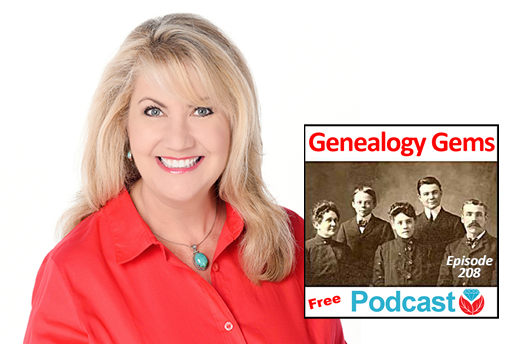
Download the show notes
In this episode:
- A free webinar!
- Great comments from you: An inspiring Google Books success story, how one listener gets her shy husband talking about his life story, and a listener’s own version of the poem, “Where I’m From”
- The Archive Lady talks to us about historical scrapbooks at archives that may be packed with genealogy gems for us
- A genealogy hero who saved a life story
- Your first look at RootsTech 2018
NEWS: FREE WEBINAR
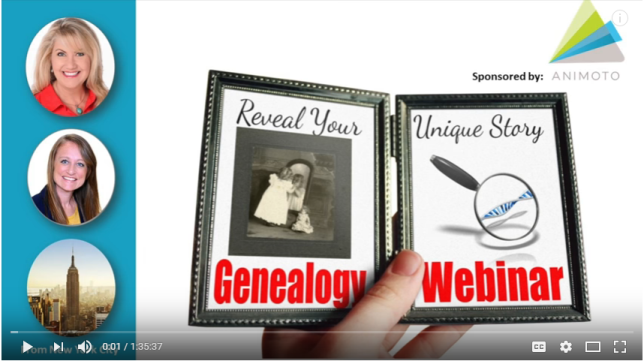
“Reveal Your Unique Story through DNA & Family History”
Handouts:
Googling and Making Videos with Lisa Louise Cooke
Newspaper Research Worksheet from Lisa Louise Cooke
Genetic Genealogy: Here’s What You Need to Know from Your DNA Guide Diahan Southard
NEWS: FIRST LOOK AT ROOTSTECH 2018
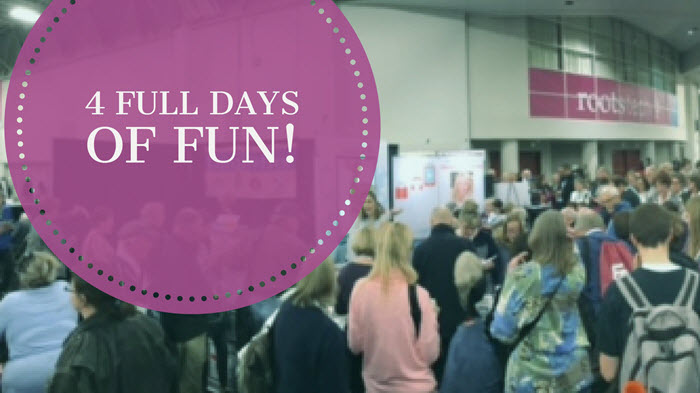
Click here for more on RootsTech 2018
Going to RootsTech for the first time? Read this RootsTech Q&A.
MAILBOX: PAT INTERVIEWS HER SHY HUSBAND

“Remembering Dad” video
Pat’s tip: When someone is shy about sharing life stories, interview them informally while traveling. Pat uses her iPad to transcribe his responses, then polishes it up when she gets home and transfers it to her own computer. “Eventually we will have enough to write the story of his life, with lots of pictures. And it’s completely painless.”
MAILBOX: GOOGLE BOOKS SUCCESS STORY FROM KIM
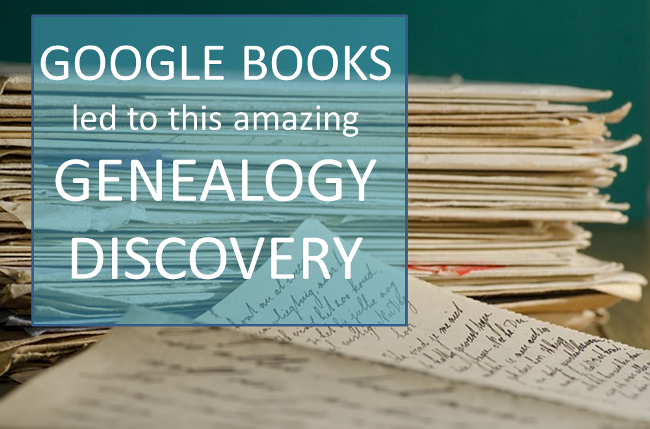
Link image to:
Click here for another inspiring genealogy discovery using Google Books?with how-to tips and a free video preview of Lisa Louise Cooke’s Premium video tutorial, “Google Books: The Tool You Need Every Day”
MAILBOX: “WHERE I’M FROM” POEM SUBMISSION
Genealogy Gems Podcast Episode 185: Learn more about the “Where I’m From” poetry project and hear a conversation with the original author, Kentucky poet laureate George Ella Lyon.
THE ARCHIVE LADY: HISTORICAL SCRAPBOOKS
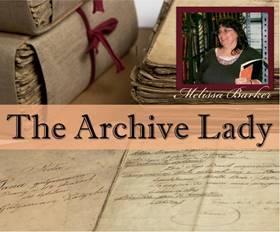
Scrapbooks are one of my favorite record sources to do genealogy research in and to also process in the archives. There are all kinds of scrapbooks; each and every one is unique and one-of-a-kind. They were put together with love and the hope that what was saved and pasted onto those pages will be remembered.
The origins of scrapbooking is said to go back to the 15th century in England and it is still a hobby enjoyed by many today. Most archives, libraries, historical and genealogical societies have scrapbooks in their collections. They will most likely be found in the Manuscript Collection as part of a specifically named collection.
Scrapbooks contain all kinds of wonderful genealogical records, photographs and ephemera. There is even a scrapbook in the Houston County, Tennessee Archives that has candy bar wrappers pasted in it. This particular scrapbook is one of my absolute favorites. It was compiled and owned by Evelyn Ellis and dates to the 1930’s and 1940’s.
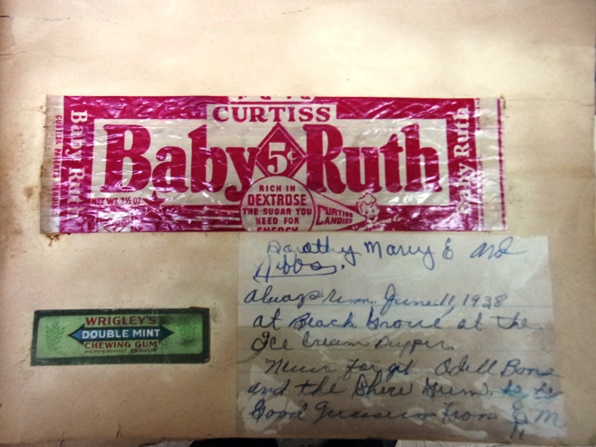
Among the normal newspaper clippings and event programs are interesting pieces such as a Baby Ruth candy bar wrapper with a handwritten note by Evelyn that reads “Always remember June 11, 1938 at Beach Grove at the Ice Cream Supper.” There is also an original ticket pasted into the scrapbook from the Grand Ole Opry in Nashville, Tennessee where Evelyn Ellis visited and recorded her comments on April 1, 1939.
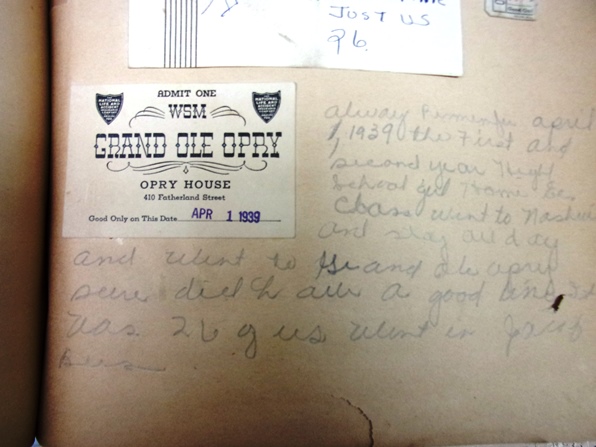
There are scrapbooks for just about any subject. Aside from personal scrapbooks, you can find war scrapbooks, obituary clipping scrapbooks and scrapbooks that collected and recorded local or national events. The obituaries found in scrapbooks could be a real find because sometimes they are the only pieces of the newspaper that survive and can be a treasure trove for any genealogist. Many scrapbooks contain one-of-a-kind documents, photographs and ephemera.
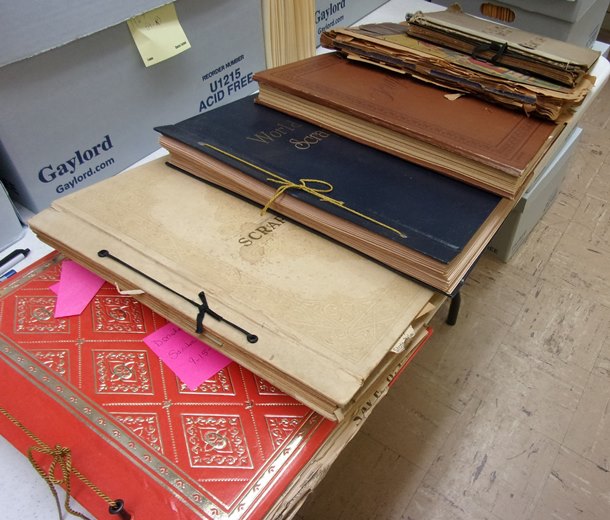
To find scrapbooks in an archive, ask the archivist if they have any scrapbooks in their records collections. Many times scrapbooks are housed with a particular manuscript collection and will be listed in the finding aid. Some archives have a collection of just scrapbooks that have been donated to them and can be easily accessed. Most scrapbooks will not be on research shelves and will be stored in back rooms at the archives and will have to be requested. You should also check the archives online catalog for any listings of scrapbooks before you jump in the car and drive to the archives.
I encourage all genealogists to check with the archive in the area where your ancestors were from and see if they have any scrapbooks in their archived records collections. Scrapbooks are like time capsules: you don’t know what will be found in them until you open them up.
BONUS CONTENT for Genealogy Gems App Users

If you’re listening through the Genealogy Gems app, your bonus content for this episode is a PDF with tips for what to do if your own scrapbook gets wet. The Genealogy Gems app is FREE in Google Play and is only $2.99 for Windows, iPhone and iPad users.
ANIMOTO

Start creating fabulous, irresistible videos about your family history with Animoto.com. You don’t need special video-editing skills: just drag and drop your photos and videos, pick a layout and music, add a little text and voila! You’ve got an awesome video! Try this out for yourself at Animoto.com.
MYHERITAGE.COM
MyHeritage.com is the place to make connections with relatives overseas, particularly with those who may still live in your ancestral homeland. Click here to see what MyHeritage can do for you: it’s free to get started.
GEM: SAVING A LIFE STORY
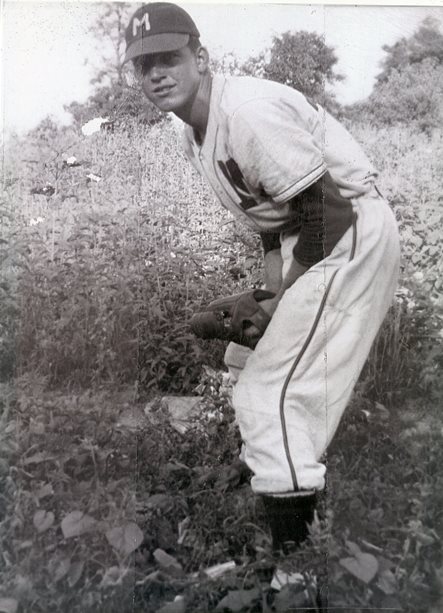
Original story on SWVA Today: “String of Pearls: Marion’s Bob White Shares Family History Collection” by Margaret Linford, Columnist
Smyth County Public Library Local History webpage
Genealogy Gems how-to resources to help you:
Video record a loved one telling their life stories
How to video record a fantastic family history interview
How to create a family history video with Animoto
Digitize and share your research and your own life story: Interview with Larsen Digital in Genealogy Gems Podcast episode 183
How to Start Blogging series in the free Family History: Genealogy Made Easy podcast (episodes 38-42) and this article: 3 Ways to Improve Your Genealogy Blog
RootsMagic family history software has publishing tools (for print and online publishing):
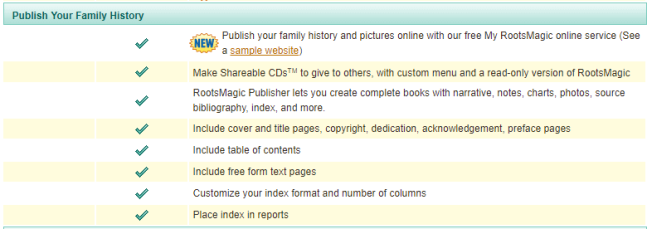

Lisa Louise Cooke uses and recommends RootsMagic family history software. From within RootsMagic, you can search historical records on FamilySearch.org, Findmypast.com and MyHeritage.com. RootsMagic is now fully integrated with Ancestry.com: you can sync your RootsMagic trees with your Ancestry.com trees and search records on the site.
A BRILLIANT WAY TO “MEET” YOUR ANCESTOR

Your DNA Guide Diahan Southard shared this story from Christine:
“Friday night I brought out large cut out of my Grandmother, Christine Doering, sitting in an easy chair so it looks like she is talking with you, and I played a recording done in 1970’s of her talking and giggling about coming to America in 1896 at the age of 9. For some they had never heard her voice before.”
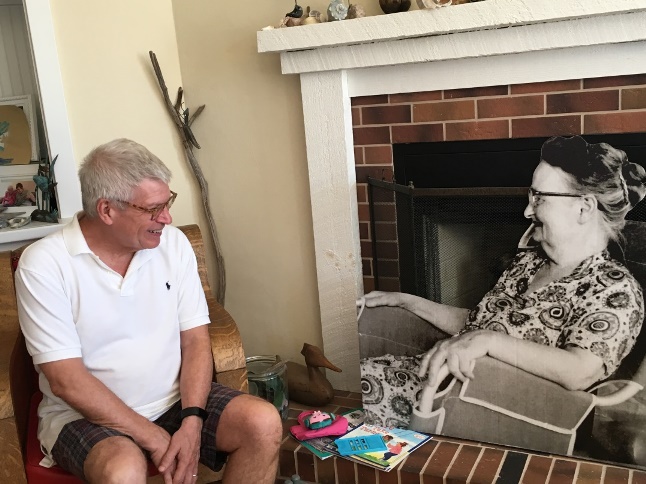
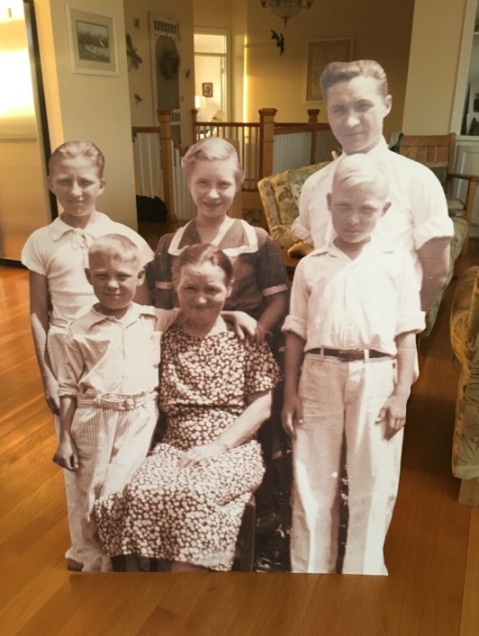
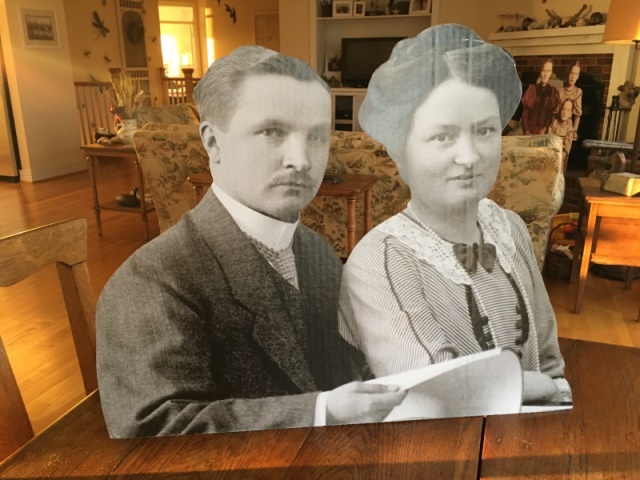
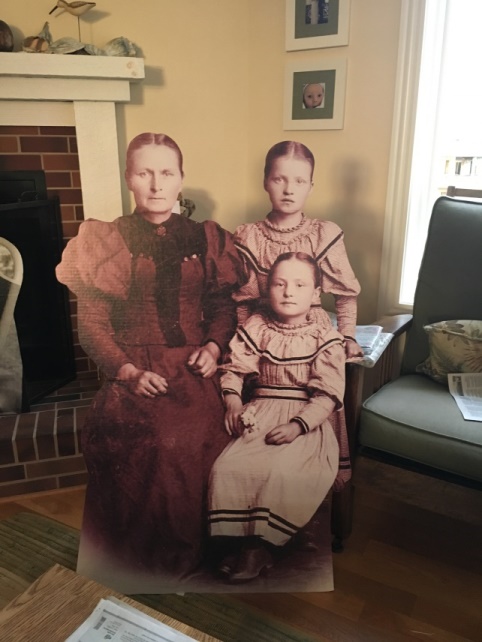
Learn more about Lisa Louise Cooke’s Genealogy Gems Podcast:
Explore our website at www.genealogygems.com,
Subscribe to our free weekly email newsletter (from the home page on the website)
Subscribe to the free Genealogy Gems YouTube channel.
PRODUCTION CREDITS
Lisa Louise Cooke, Host and Producer
Sunny Morton, Editor
Diahan Southard, Your DNA Guide, Content Contributor
Vienna Thomas, Associate Producer
Hannah Fullerton, Production Assistant
Lacey Cooke, Service Manager
FREE NEWSLETTER:

Subscribe to the Genealogy Gems newsletter to receive a free weekly e-mail newsletter, with tips, inspiration and money-saving deals.
Check out this new episode!
by Lisa Cooke | May 24, 2017 | 01 What's New, Book Club, Writing Family History
Wish you could write family history like a master storyteller? Take a page from best-selling novelist Fannie Flagg’s fiction-writing. These three steps will help you bring your ancestors’ stories to life, so that their stories become as compelling to your relatives as they are to you.
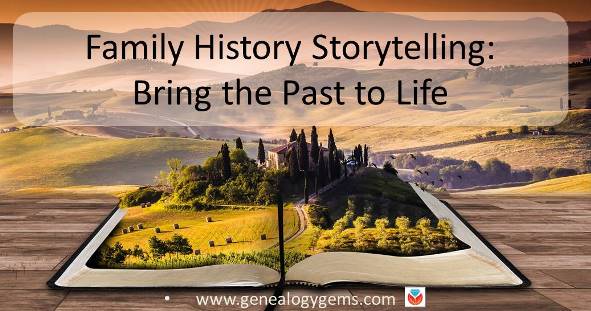
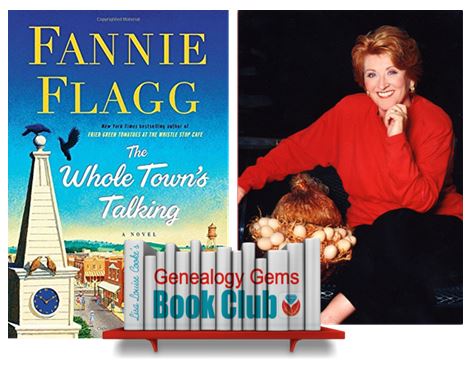 Powerful storytellers create characters so vivid, we miss them when we finish reading. They take us into worlds that become just as real. Experiencing their stories changes us, even if just subtly. Fannie Flagg is one of this generation’s great storytellers, and she does all three of these things in The Whole Town’s Talking, our current Genealogy Gems Book Club title. The book is an excellent example for family history storytellers who want to bring their own ancestors to life in narratives that captivate and change their own loved ones.
Powerful storytellers create characters so vivid, we miss them when we finish reading. They take us into worlds that become just as real. Experiencing their stories changes us, even if just subtly. Fannie Flagg is one of this generation’s great storytellers, and she does all three of these things in The Whole Town’s Talking, our current Genealogy Gems Book Club title. The book is an excellent example for family history storytellers who want to bring their own ancestors to life in narratives that captivate and change their own loved ones.
3 Keys to Amazing (Family History) Storytelling
1. Create vivid characters.
Lordor Nordstrom seems an unlikely hero at the beginning of The Whole Town’s Talking. He’s a 30-something single Swede who has come to the heartland of the U.S. to build a life. He’s a quiet man, a hard worker who starts a dairy farm. But then he starts to stand a little straighter and attract people his direction because he has a dream of what his world should look like. He places ads in newspapers and convinces other Swedes to settle nearby. Swedetown is born around him. We start to see that his quiet determination and vision are accomplishing great things for himself and others. Then this quiet, unprepossessing fellow gets up the nerve to place another newspaper ad:
Swedish man of 37 looking for Swedish lady for marriage. I have a house and cows.
But when he gets a response from a “24-year old Swedish lady of the Lutheran faith,” he starts to sweat and stammer and second-guess himself. He gets his picture taken: he looks like a hayseed. He gets a haircut: the bowl-cut style was a bad idea. But he persists despite feeling totally unready for the sweet, refined young lady who, after more stammering and shyness, eventually and very willingly becomes his bride.
NOW YOU TRY IT:
Think of an ancestor you want to write about. What do you know about him or her? Do you know she was born in a tiny village, or that he lost three siblings at once in a cholera epidemic? Do you know he was the first in the family to learn to read? Or that her husband disappeared when she had three children and one on the way?
You have to pay close attention to historical records to notice those kinds of details. You also have to think about and make connections between different events. That’s how you’ll realize those three siblings all died at the same time, and that not long after, he left school to take care of his family. Then you can start to create a “character” out of those scrawled names and details in all those old records.
Write down 5-10 specific details you know about an ancestor. If you can’t think of any, start scrutinizing historical records. Note physical details in military records or passport applications. Did he naturalize? Could she read English? How old were they when they married? Construct a timeline and make connections: “Oh my, he lost his wife in childbirth at the same time his father died. Suddenly he was caring for both his 82-year old mother and a newborn!”
2. Paint the historical backdrop.
Fannie places the story of Lordor and his want-ad bride Katrina in the beautiful but largely unknown American Midwest. The future of that country was as unwritten as the future of this couple. Gradually a small immigrant town comes into being, content to be its modest, friendly self. Fannie tells us about Main Street, the local businesses, the churches, the town’s main families and how they are related. We get just enough gossip to feel we know the people. In fact, we can imagine ourselves stopping in to gossip over a fence or attend a church potluck. The things that happen to the characters are more imaginable because we can picture the setting.
The story of Lordor and Katrina doesn’t just unfold against the settling of the Midwest frontier, though. As the narrator, Fannie Flagg puts Lordor and Katrina’s marriage into historical context, too. They were like many mail-order couples during a period of great change and movement in American history, she says:
On both sides, it was a desperate game of chance. But, surprisingly, many marriages did work out, and the results helped populate the country with a hardy and adventurous stock. People were willing to travel anywhere, sacrifice anything, to own their own land, to be free and be independent.
Though Fannie is writing fiction, she’s writing within a real historical world that she researches and loves to bring to life.
NOW YOU TRY IT:
We, too, can paint detailed portraits of our ancestors’ lives on a broader canvas of history. Do some reading about the history of the town and region. Look for trends or patterns or events that would specifically have affected your ancestors, based on where they lived, their ethnic or religious identity, financial status, gender, etc.
Click here to read more tips for learning the history surrounding your ancestors’ lives: Tell Your Ancestor’s Story: Use Social History for Genealogy
3. Give readers something to think about, or a reason this story matters.
The title of this story–The Whole Town’s Talking– doesn’t just refer to neighborly gossip on the streets and church pews of Swedetown (which eventually becomes Elmwood Springs). The key to this story is what happens at the town cemetery, on a hill overlooking the town on land donated by Lordor. After town residents die, we meet them again when they “wake up” in their cemetery plots. They still have their memories and personalities. They banter with each other and fawn over loved ones who come to visit their graves. They keep up on town gossip and their grandchildren and changes in society as best they can.
What I took away from this delightful scenario is the idea that family love persists past the grave. That memories of loved ones we honor at a cemetery may just be powerful enough to keep them there and, in a sense, alive. That they continue on.
NOW YOU TRY IT:
It’s not always easy to find a running theme, meaning, or message in a life you’ve researched. After all, you don’t see the whole thing. And most lives don’t unfold along a single theme. But if you’re excited enough to write about an ancestor, something about their story moves you. What is it? Try to put your finger on it. And then write about it, like this short passage about my own ancestor:
“What I see in Thomas Selby’s life is a man who never stopped moving or building. The challenges and opportunities of the frontier were to him an open door, beckoning to him. He started life with no apparent advantages, given away by his mother. That didn’t seem to dim his confidence. He was apparently uneducated, yet he studied law and argued a case before the Ohio supreme court. He bought up land and established friendships in southeast Ohio, then lit out for the California Gold Rush. He failed dramatically: the shipload of flour he took to sell the Goldrushers spoiled and he apparently had to walk all the way home. It took him seven years. But being broke didn’t stop him from buying homestead land in Missouri on the way home and immediately relocating his family. Eventually he settled there and spread his energies into creating enterprises: a flourishing farm, a general store, and judgeship.
I also see a man who seems to have totally excluded his wife and children when making decisions about the future. It was a common attitude for his time. But I think of him striding up to his yard on an evening seven years after disappearing, ragged and worn from the road. Family lore says he saw his wife come to the door with a gun and yelled, “Don’t shoot, Huldy, it’s me!” But if I were Huldy, finding out it was him–and that he’d just decided to move me into the wilderness without even consulting me–might just have made me pull the trigger.”
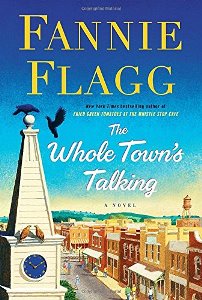 For more storytelling inspiration, curl up with Fannie’s Flagg’s novel The Whole Town’s Talking–and then tune in to the upcoming Genealogy Gems Premium Podcast episode 148, in which Fannie herself joins us on the show. (Premium website membership required–but we play an excerpt in the free Genealogy Gems Podcast episode #204.
For more storytelling inspiration, curl up with Fannie’s Flagg’s novel The Whole Town’s Talking–and then tune in to the upcoming Genealogy Gems Premium Podcast episode 148, in which Fannie herself joins us on the show. (Premium website membership required–but we play an excerpt in the free Genealogy Gems Podcast episode #204.
by Lisa Cooke | Aug 12, 2015 | 01 What's New, Book Club, Genealogy TV, images, Memory Lane, Military, United States
 An incredible tale of deception during World War II. Inspiring research and storytelling techniques. Learn about the Ghost Army–and the creation of its PBS documentary–in the new, free Genealogy Gems Podcast episode 182.
An incredible tale of deception during World War II. Inspiring research and storytelling techniques. Learn about the Ghost Army–and the creation of its PBS documentary–in the new, free Genealogy Gems Podcast episode 182.
In the summer of 1944, a handpicked group of young GIs landed in France to conduct a secret mission. They were to create an elaborate façade of military might for an audience, the German army. These men had one goal: to fool the enemy into believing they were an American army thousands strong, and draw their attention away from the actual fighting troops.
 In this podcast episode, we celebrate the Twenty-third Headquarters Special Troops–known as the Ghost Army–with my special guest Rick Beyer, author of the book The Ghost Army of World War II: How One Top-Secret Unit Deceived the Enemy with Inflatable Tanks, Sound Effects, and Other Audacious Fakery and director and screenplay author of the acclaimed documentary film Ghost Army, which premiered on PBS.
In this podcast episode, we celebrate the Twenty-third Headquarters Special Troops–known as the Ghost Army–with my special guest Rick Beyer, author of the book The Ghost Army of World War II: How One Top-Secret Unit Deceived the Enemy with Inflatable Tanks, Sound Effects, and Other Audacious Fakery and director and screenplay author of the acclaimed documentary film Ghost Army, which premiered on PBS.
Rick joins us for a riveting conversation. He explains the three divisions of the Ghost Army, and how they fulfilled their duties with courage and creativity. Then he takes us behind the scenes of the book to explore research strategies and in particular, effective interviewing techniques. Finally he talks to us about putting it all together: storytelling, the integration of all the art, photos and documents, and fantastic catchy chapter titles that make you want to read.
This is a must-hear episode whether you love history, mystery, military stories, family history writing advice or just listening in on a great conversation! Thank you for sharing this episode with others who will enjoy it!
 If you love author interviews, check out the Genealogy Gems Book Club. We regularly interview writers of best-selling fiction and nonfiction titles that catch the interest of family history lovers.
If you love author interviews, check out the Genealogy Gems Book Club. We regularly interview writers of best-selling fiction and nonfiction titles that catch the interest of family history lovers.































